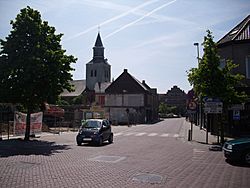Buggenhout facts for kids
Quick facts for kids
Buggenhout
|
|||
|---|---|---|---|
 |
|||
|
|||
| Country | Belgium | ||
| Community | Flemish Community | ||
| Region | Flemish Region | ||
| Province | East Flanders | ||
| Arrondissement | Dendermonde | ||
| Area | |||
| • Total | 25.25 km2 (9.75 sq mi) | ||
| Population
(2018-01-01)Lua error in Module:Wd at line 1575: attempt to index field 'wikibase' (a nil value).
|
|||
| • Total | Lua error in Module:Wd at line 1,575: attempt to index field 'wikibase' (a nil value). | ||
| Postal codes |
9255
|
||
| Area codes | 052 | ||
| Website | www.buggenhout.be | ||
Buggenhout is a town in Belgium, located in the province of East Flanders. It is part of a region called the Denderstreek. The town includes the smaller areas of Buggenhout itself, Briel, Opdorp, and Opstal.
In 2021, about 14,689 people lived in Buggenhout. The town covers an area of 25.25 square kilometers.
Buggenhout is famous for its large forest, the Buggenhoutbos. This forest is the biggest one in all of East Flanders. Did you know that the exact middle point of Flanders is in Opdorp, a part of Buggenhout?
Buggenhout is also home to two breweries. These are Bosteels Brewery, which makes popular beers like "Tripel Karmeliet" and "Kwak," and Brouwerij Malheur, known for its "Malheur" beers.
Contents
What Does the Name Buggenhout Mean?
The name "Buggenhout" has a cool history! It originally meant "beechwood" or "beech forest." Imagine a forest full of beech trees.
The name comes from older languages. In Middle Dutch, it was Bucghenhout, and even older, in Old Dutch, it was Bukenholt. The word Buken is related to "beech trees," and holt means "forest" or "wood."
Today, Buggenhout still has a large forest area called the Buggenhoutbos. This shows how the town's name truly fits its nature.
A Quick Look at Buggenhout's History
The village of Buggenhout was first mentioned in writing in the year 1125. A very long time ago, it was part of an important area called the Duchy of Brabant.
Because of some disagreements and fights within the region, the land was taken away from its owners. The forest became "crown land," meaning it belonged to the ruler. The village of Buggenhout then became two separate "heerlijkheden," which were like large landed estates or lordships.
After the French Revolution, a big change happened. Buggenhout was then moved to the province of East Flanders, where it remains today.
Images for kids
See also
 In Spanish: Buggenhout para niños
In Spanish: Buggenhout para niños








